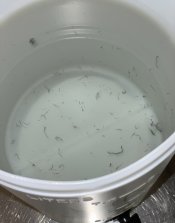I have been toning a fair amount of prints in selenium toner without really paying attention to toner capacity, until now. I have now made some calculations (see below), which indicate that 1 litre of working solution at strength 1+19 is only good for two prints at 12x16"...a surprisingly low number I must say...somthing must be "wrong" in my assumptions??!!
In my (perhaps limited) experience, it is possible to more prints than indicated above, but when toning for increased D-max I actually find it quite hard to judge when toning is actually effective or not (even if sticking to the practice of having a wet print as reference). In an attempt to inform myself on the capacity of selenium at weaker strengths I have searched on Photrio, and also elsewhere on internet, but without any informative hits. The lack of information made me write this post and ask...
What is the common understanding on the capacity of selenium toners at higher dilutions? Anyone who can provide some insights?
Best regards
Henrik
Calculations:
Inspecting datasheets by Kodak, Ilford and Fotolabor (makers of LP Selenia, Rollei Selenia, etc) they all seem to agree that 1 liter of *working solution* at strength 1+3 should be good for 25 sheets of 8x10".
Given the information above I deduce that 1 liter of *concentrate* is is good for 4*25=100 pcs of 8x10, or equivalently 8000 sq inch, right? I normally print on 12x16" (equals 192 sq. inch) paper and tone in selenium at strength 1+19. Continuing on my calculations, I deduce that 1 litre of *concentrate* should be sufficient for approx 42 sheets of 12x16" (8000 / 192 = 41.67). Following my reasoning, this imply that 1 liter of working solution at strength 1+19 is only good for 2 prints of size 12x16"
In my (perhaps limited) experience, it is possible to more prints than indicated above, but when toning for increased D-max I actually find it quite hard to judge when toning is actually effective or not (even if sticking to the practice of having a wet print as reference). In an attempt to inform myself on the capacity of selenium at weaker strengths I have searched on Photrio, and also elsewhere on internet, but without any informative hits. The lack of information made me write this post and ask...
What is the common understanding on the capacity of selenium toners at higher dilutions? Anyone who can provide some insights?
Best regards
Henrik
Calculations:
Inspecting datasheets by Kodak, Ilford and Fotolabor (makers of LP Selenia, Rollei Selenia, etc) they all seem to agree that 1 liter of *working solution* at strength 1+3 should be good for 25 sheets of 8x10".
Given the information above I deduce that 1 liter of *concentrate* is is good for 4*25=100 pcs of 8x10, or equivalently 8000 sq inch, right? I normally print on 12x16" (equals 192 sq. inch) paper and tone in selenium at strength 1+19. Continuing on my calculations, I deduce that 1 litre of *concentrate* should be sufficient for approx 42 sheets of 12x16" (8000 / 192 = 41.67). Following my reasoning, this imply that 1 liter of working solution at strength 1+19 is only good for 2 prints of size 12x16"



